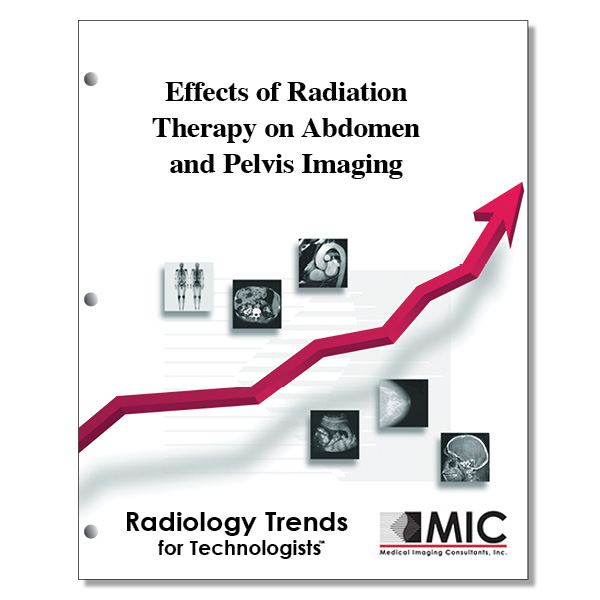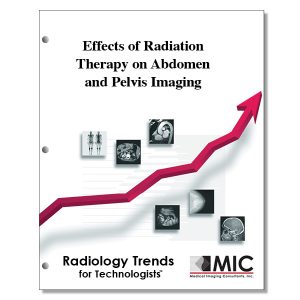

Effects of Radiation Therapy on Abdomen and Pelvis Imaging
A review of treatment methods and radiobiology concepts that underlie radiation-related changes seen in specific tissues at imaging.
Course ID: Q00372 Category: Radiology Trends for Technologists Modalities: CT, MRI, Nuclear Medicine, Radiation Therapy4.0 |
Satisfaction Guarantee |
$39.00
- Targeted CE
- Outline
- Objectives
Targeted CE per ARRT’s Discipline, Category, and Subcategory classification:
[Note: Discipline-specific Targeted CE credits may be less than the total Category A credits approved for this course.]
Computed Tomography: 1.75
Procedures: 1.75
Abdomen and Pelvis: 1.75
Magnetic Resonance Imaging: 1.75
Procedures: 1.75
Body: 1.75
Nuclear Medicine Technology: 1.25
Procedures: 1.25
Endocrine and Oncology Procedures: 1.25
Registered Radiologist Assistant: 3.25
Procedures: 3.25
Abdominal Section: 3.25
Sonography: 1.75
Procedures: 1.75
Abdomen: 1.50
Gynecology: 0.25
Radiation Therapy: 3.50
Safety: 0.25
Radiation Protection, Equipment Operation, and Quality Assurance: 0.25
Procedures: 3.25
Treatments: 3.25
Outline
- Introduction
- Radiation Biology: A Refresher
- External Radiation Delivery Techniques
- Traditional External-Beam Radiation Therapy
- Conformal Radiation Therapy
- Intensity-modulated Radiation Therapy
- Stereotactic Body Radiation Therapy
- Proton Beam Therapy
- Internal Radiation Delivery Techniques
- Brachytherapy
- Radioembolization
- Posttherapeutic Imaging Findings
- Liver
- Findings after External-Beam Radiation Therapy
- Findings after Radioembolization
- Spleen
- Pancreas
- Bowel
- Kidneys and Ureters
- Bladder
- Female Pelvic Organs
- Male Pelvic Organs
- Blood Vessels
- Bones and Marrow
- Secondary Malignancies
- Liver
- Conclusion
Objectives
Upon completion of this course, students will:
- differentiate the various radiation delivery techniques
- define innocent bystander tissue
- know the primary reason for cell death
- understand the rationale for fractionating the dose
- differentiate between conditional and inherent radiation sensitivity
- define cellular sensitivity
- know the most common acute effect in epithelial tissue
- know the effect of radiation on stromal parts of organs
- know which was the first cancer to be treated with radiation after 1895
- understand the rationale for using frontal and lateral radiographs for treatment planning
- define the date of progress
- understand dynamic moving leaves for collimation
- understand the significance of “beams eye view” for sparing of normal tissue
- know the relationship between radiosensitivity and cellular regeneration
- be familiar with IMRT
- describe how IMRT is modeled
- differentiate the high and low dose region in relation to IMRT
- understand the differences between SBRT and IMRT
- understand the objectives of fractionation in radiation therapy
- describe the physical properties of a proton beam when traversing tissues
- know the major advantages of proton beam therapy
- describe the methods for delivering radiation in brachytherapy
- state the radionuclide used for prostate cancer brachytherapy
- state the method of brachytherapy for gynecologic cancer
- know the type of hepatic malignancies treated by radioembolization
- understand the radioactive source used for radioembolization
- know the factors that affect the likelihood of recurrence of disease after radiation
- be familiar with the radiation dose ranges at which imaging changes occur
- describe the histologic changes in the liver after radiation therapy starts
- recognize the radiation changes in liver parenchyma as seen on CT images
- recognize that using SBRT or IMRT will change the shape of the treated zone
- understand the timeline in which veno-occlusive disease manifests
- recognize how regeneration of the liver manifests
- recognize the tumor changes after radioembolization
- state the dose at which the spleen exhibits damage
- know the relationship between cell turnover and radiosensitivity in the small bowel
- recognize the chronic effects of radiation exposure in the small bowel
- understand the difficulty differentiating between similar radiation effects and surgical effects
- recognize imaging changes due to partial exposure of the kidney to radiation for treatment of adjacent structures
- recognize the acute effects of radiation on the bladder
- know the terminology associated with ovarian preservation
- recognize the chronic effects of radiation in the larger blood vessels
- state the one tissue where radiation-induced effects are unique
- know which type of radiation-induced tumor is aggressive
- understand the basis of radiosensitivity and the resulting effects of radiation-induced injury
